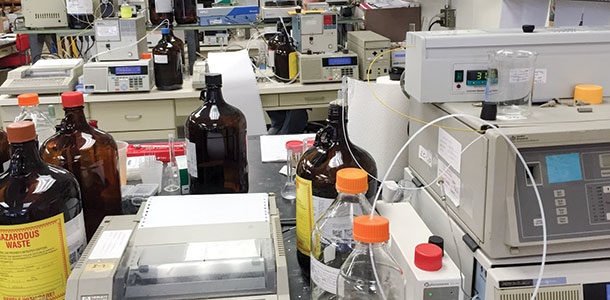Editor’s note: This article was written as a follow-up to the piece, “Say goodbye to NPEs in teat dip,” published in the Jan. 19, 2015 issue of Progressive Dairyman. Editor's note: This article has been corrected to indicate the duties of the National Mastitis Council in recommending protocols, not testing for efficacy of teat dips. Recent action in international markets banning nonyl-phenol ethoxylates (NPE) in milk has raised U.S. dairy producers’ awareness of the substance in teat dips.
Used as a surfactant to bind iodine and keep it in suspension, NPEs have provided economical disinfectants and skin conditioners for years.
But the science now shows NPEs can leave residue in milk, and that residue can have health and environmental implications. And that creates economic implications. Companies exporting milk to China, Canada and the European Union are not allowed to have NPE residue in their product. That means U.S. producers supplying that market must avoid the ingredient.
Product manufacturers, accustomed to meeting the needs of European markets where NPEs have long been banned, are responding with new non-iodine NPE-free products for the U.S.
But are those products really safe? While most producers trust their supplier representative and the company they represent, there is a faction of the industry that isn’t so sure that’s the safest way to operate.
“The milk is tested for NPEs,” says David Wood, vice president of technical services for CLSolutions LLC, an Omaha company that specializes in contract manufacturing, packaging and design, and includes a non-NPE teat dip in its lineup. “But there’s no way to know where they came from without testing the elements on the front end.”
The National Mastitis Council recommends protocols for testing the efficacy of teat disinfectants and provides protocols for researchers and/or manufacturers to follow when evaluating teat dips.
“Therefore,” says an NMC publication, “teat dips can be manufactured and marketed without demonstrating effectiveness or safety. In this ‘buyer beware’ market, the consumer is responsible for determining whether a particular product has been tested and proven effective.
Before using or recommending a particular product, request written information from the manufacturer on compliance with federal regulations and results of controlled research studies showing effectiveness.” The same goes for safety.
That’s not to imply teat dips are not controlled. They are classified as animal drugs and must be registered with the FDA. That means manufacturers must follow rigid good manufacturing processes (GMP) set by the FDA and manufacturing facilities are subject to FDA inspection, including review of raw materials, equipment, lab standards and labeling.
At the dairy, production methods can account for NPE contamination in milk. Failure to thoroughly clean detergent from equipment can leave NPE residue that appears in the final product.
Or the NPEs may come from the products themselves. “The label may not list NPEs as an ingredient, but it is not required to say ‘NPE-free,’” explains Wood. “It doesn’t hurt to have verification of the contents of the products you’re using.”
Some producers are seeking third-party testing to get that verification.
Custom Industrial Analysis Labs (CIA Labs) in St. Joseph, Missouri, is one lab that performs that type of product testing. Labs like CIA Labs are often enlisted by manufacturers during the research and development phase to perform testing that larger labs avoid for efficiency purposes. Likewise, smaller labs are more willing to perform the individual testing producers may desire.
“So far the requests have been few,” says Dr. Richard Schwarz, CEO of CIA Labs, “but the potential is there.”
The lab uses a process known as high-pressure liquid chromatography (HPLC) to test for NPEs. HPLC is a method for separating and quantitatively determining compounds or ingredients.
Testing begins by using a reference standard, or pure material, in this case NPE. The standard is injected into the HPLC. At a certain time, a peak for the NPE is detected by the instrument and noted on a graph.
The sample mixture in question is then injected into the HPLC, and the researcher looks for a possible peak at the same time the NPE standard was noted.
If no corresponding peak is noted, the mixture is free of NPE. If it is present, the amount of NPE is calculated.
“So far, in the teat dips we’ve tested, there were no NPEs present,” Schwarz says.
He adds producer concern should probably be correlated to the source of the product. “It depends on where they’re getting it, where it’s made. If it’s made in a country without strong environmental controls, there could be cause for concern.”
Cost for the testing is $150 to $200 per sample.
Wood sees value in testing – as a way to continue competitiveness in foreign markets and as a way to maintain transparency in a time when scrutinizing eyes are focused on agriculture.
“With a global focus on sustainability and environmental concerns, people are watching,” he says.
And so are industry insiders.
“Producers are more interested than ever in what goes on downstream,” he adds. “We should be testing everything to know what’s in there. That’s part of how the dairy industry will continue to adjust and improve.”
Future teat dips will need to meet new and expanding environmental regulations, leave non-toxic residues and be effective in meeting worldwide demands. And it will be up to the producer to ensure the products he uses meet those expectations. PD
Terri Queck-Matzie is a freelance writer in Fontanelle, Iowa.
PHOTO: Testing for NPEs in teat dips involves a process known as high-pressure liquid chromatography (HPLC). CIA Labs in St. Joseph, Missouri, is one independent lab that offers the testing to dairy producers. Photo courtesy CIA Labs.





